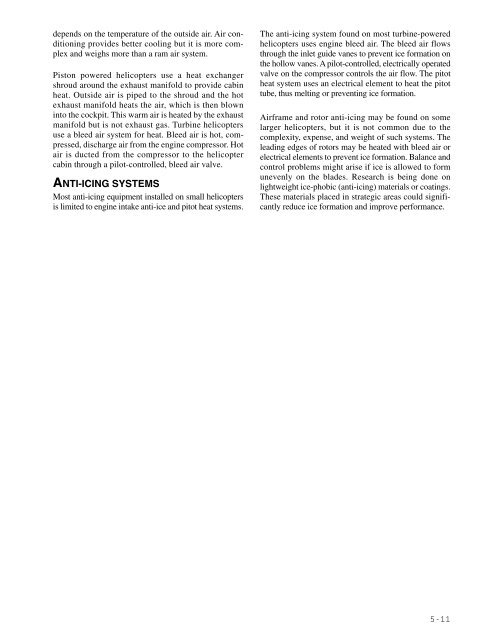Rotorcraft Flying Handbook, FAA-H-8083-21
Rotorcraft Flying Handbook, FAA-H-8083-21
Rotorcraft Flying Handbook, FAA-H-8083-21
You also want an ePaper? Increase the reach of your titles
YUMPU automatically turns print PDFs into web optimized ePapers that Google loves.
depends on the temperature of the outside air. Air conditioning<br />
provides better cooling but it is more complex<br />
and weighs more than a ram air system.<br />
Piston powered helicopters use a heat exchanger<br />
shroud around the exhaust manifold to provide cabin<br />
heat. Outside air is piped to the shroud and the hot<br />
exhaust manifold heats the air, which is then blown<br />
into the cockpit. This warm air is heated by the exhaust<br />
manifold but is not exhaust gas. Turbine helicopters<br />
use a bleed air system for heat. Bleed air is hot, compressed,<br />
discharge air from the engine compressor. Hot<br />
air is ducted from the compressor to the helicopter<br />
cabin through a pilot-controlled, bleed air valve.<br />
ANTI-ICING SYSTEMS<br />
Most anti-icing equipment installed on small helicopters<br />
is limited to engine intake anti-ice and pitot heat systems.<br />
The anti-icing system found on most turbine-powered<br />
helicopters uses engine bleed air. The bleed air flows<br />
through the inlet guide vanes to prevent ice formation on<br />
the hollow vanes. A pilot-controlled, electrically operated<br />
valve on the compressor controls the air flow. The pitot<br />
heat system uses an electrical element to heat the pitot<br />
tube, thus melting or preventing ice formation.<br />
Airframe and rotor anti-icing may be found on some<br />
larger helicopters, but it is not common due to the<br />
complexity, expense, and weight of such systems. The<br />
leading edges of rotors may be heated with bleed air or<br />
electrical elements to prevent ice formation. Balance and<br />
control problems might arise if ice is allowed to form<br />
unevenly on the blades. Research is being done on<br />
lightweight ice-phobic (anti-icing) materials or coatings.<br />
These materials placed in strategic areas could significantly<br />
reduce ice formation and improve performance.<br />
5-11

















